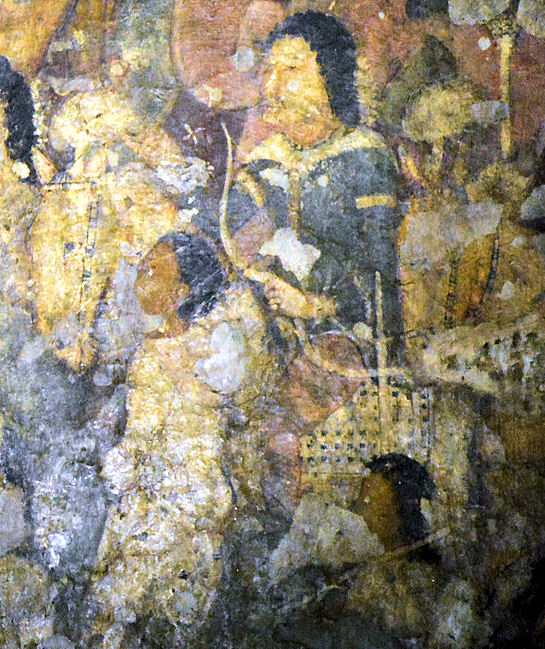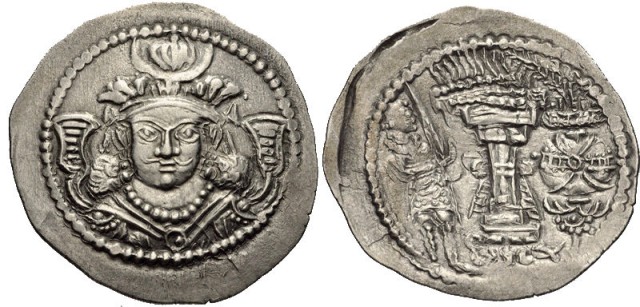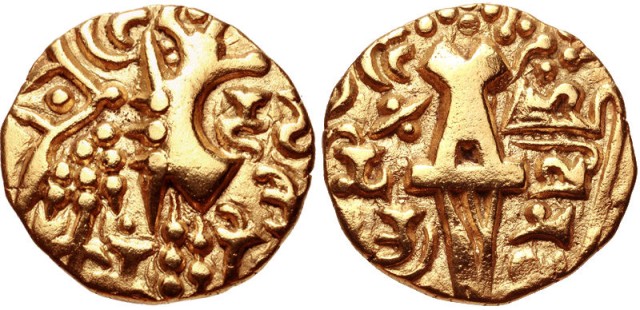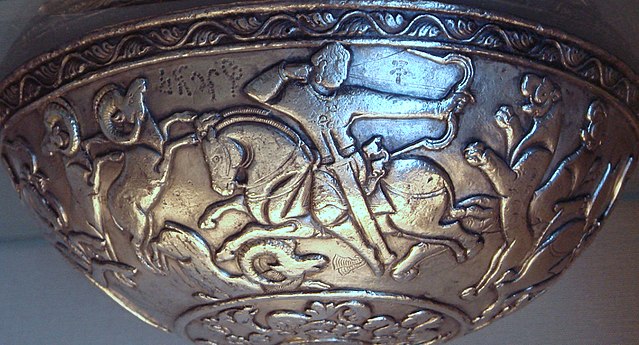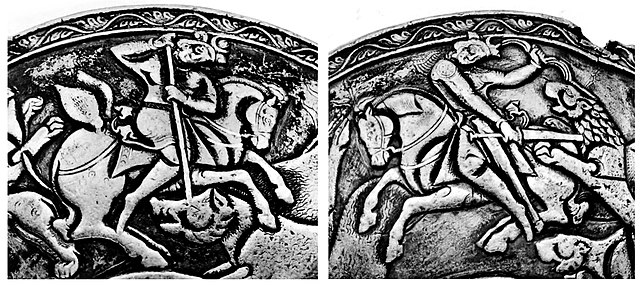
| KIDARITES
Tamga of the Kidarites
The Kidarite kingdom circa 400 Kidarites
320 - 467
Capital : Bactria, Peshawar, Taxila
Common languages : Bactrian (written)
Government : Nomadic empire
Kushanshah
• fl. 320 : Kidara
• fl. 425 : Varhran I
• fl. 500 : Kandik
Historical era : Late Antiquity
• Established : 320
•
Disestablished
: 467
Preceded by
Kushano-Sasanian Kingdom
Kushan Empire
Succeeded by
Alchon Huns
Hephthalites
Today part of : Turkmenistan, Tajikistan, Uzbekistan, Afghanistan and Pakistan
The Kidarites, or Kidar Huns, were a dynasty that ruled Bactria and adjoining parts of Central Asia and South Asia in the 4th and 5th centuries. The Kidarites belonged to a complex of peoples known collectively in India as the Hun, and in Europe as the Chionites (from the Iranian names Xwn/Xyon), and may even be considered as identical to the Chionites. The 5th century Byzantine historian Priscus called them Kidarites Huns, or "Huns who are Kidarites". The Hun / Xionite tribes are often linked, albeit controversially, to the Huns who invaded Eastern Europe during a similar period. They are entirely different from the Hephthalites, who replaced them about a century later.
The Kidarites were named after Kidar (Chinese: Jiduolo, ancient pronunciation: Kjie-ta-la) one of their main rulers. The Kidarites appear to have been a part of a Hun horde known in Latin sources as the "Kermichiones" (from the Iranian Karmir Xyon) or "Red Hun". The Kidarites established the first of four major Xionite/Hun states in Central Asia, followed by the Alchon, the Hephthalites and the Nezak.
In 360–370 CE, a Kidarite kingdom was established in Central Asian regions previously ruled by the Sasanian Empire, replacing the Kushano-Sasanians in Bactria. Thereafter, the Sasanian Empire roughly stopped at Merv. Next, circa 390-410 CE, the Kidarites invaded northwestern India, where they replaced the remnants of the Kushan Empire in the area of Punjab.
Origins :
Portrait of Kidara, king of the Kidarites, circa 350–386.
The coinage of the Kidarites imitated Sasanian imperial coinage,
with the exception that they displayed clean-shaven faces, instead
of the beards of the Sasanians, a feature relating them to Altaic
rather than Iranian lineage.
The Kidarites appear to have been synonymous with the Karmir Xyon ("Red Xionites" or, more controversially, "Red Huns"),– a major subdivision of the Chionites (Xionites), alongside the Spet Xyon ("White Xionites"). In a recently discovered seal with the image of a ruler similar to those of the Kidarite coins, the ruler named himself in Bactrian "King of the Huns and Great Kushan Shah" (uonano shao o(a)zarko (k)oshanoshao). The discovery was reportedly made in Swat.
Fire attendants with the kaftan tunic worn over trousers tucked into knee-high boots, and holding swords, on the coinage of Kidara The name of their eponymous ruler Kidara (fl. 350–385) may be cognate with the Turkic word Kidirti meaning "west", suggesting that the Kidarites were originally the westernmost of the Xionites, and the first to migrate from Inner Asia. Chinese sources suggest that when the Uar (Huá) were driven westward by the Later Zhao state, circa 320, from the area around Pingyang (modern Linfen, Shanxi), it put pressure on Xionite-affiliated peoples, such as the Kidarites, to migrate. Another theory is that climate change in the Altai during the 4th century caused various tribes to migrate westward and southward.
Contemporary Chinese and Roman sources suggest that, during the 4th century, the Kidarites began to encroach on the territory of Greater Khorasan and the Kushan Empire – migrating through Transoxiana into Bactria,where they were initially vassals of the Kushans and adopted many elements of Kushano-Bactrian culture. The Kidarites also initially put pressure on the Sasanian Empire, but later served as mercenaries in the Sassanian army, under which they fought the Romans in Mesopotamia, led by a chief named Grumbates (fl. 353–358 CE). Some of the Kidarites apparently became a ruling dynasty of the Kushan Empire, leading to the epithet "Little Kushans".
Kidarite
kingdom :
Inclusion of the Kidarite tamgha
Coin in the name of Kushano-Sasanian king Varahran, struck under Kidarite ruler Kirada, circa 340 - 345
The Kidarite tamga symbol appears to the right of the standing king. Balkh mint The first evidence are gold coins discovered in Balkh dating from the mid-4th century. The Kushano-Sasanian ruler Varahran during the second phase of his reign, had to introduce the Kidarite tamga in his coinage minted at Balkh in Bactria, circa 340-345. The tamgha replaced the nandipad symbol which had been in use since Vasudev I, suggesting that the Kidarites had now taken control, first under their ruler Kirada. Then ram horns were added to the effigy of Varahran on his coinage for a brief period under the Kidarite ruler Peroz, and raised ribbons were added around the crown ball under the Kidarite ruler Kidara. In effect, Varahran has been described as a "puppet" of the Kidarites. By 365, the Kidarite ruler Kidar I was placing his name on the coinage of the region, and assumed the title of Kushanshah. In Gandhar too, the Kidarites minted silver coins in the name of Varahran, until Kidar also introduced his own name there.
Archaeological, numismatic, and sigillographic evidence demonstrates the Kidarites ruled a realm just as refined as that of the Sasanians. They swiftly adopted Iranian imperial symbolism and titulature, as demonstrated by a seal; "Lord Ularg, the king of the Huns, the great Kushan-shah, the Samarkandian, of the Afrigan (?) family."
Most other data we currently have on the Kidarite kingdom are from Chinese and Byzantine sources from the middle of the 5th century. The Kidarites were the first Hun to bother India. Indian records note that the Hun had established themselves in modern Afghanistan and the North-West Frontier Province by the first half of the 5th century, and the Gupt emperor Skandagupt had repelled a Hun invasion in 455. The Kidarites are the last dynasty to regard themselves (on the legend of their coins) as the inheritors of the Kushan empire, which had disappeared as an independent entity two centuries earlier.
Migration into Bactria :
Kidara, circa 425–457. AR Drachm (29mm, 3.76 g, 3h). Mint C in Gandhar. Crowned bust facing slightly right. Brahmi legend around the head: Ki-da-ra Ku-sa-na-sa/ Fire altar flanked by attendants Around 350, the Sasanian Emperor Shapur II (ruled 309 to 379) had to interrupt his conflict with the Romans, and abandon the siege of Nisibis, in order to face nomadic threats in the east: he was attacked in the east by Scythian Massagetae and other Central Asian tribes. Around this time, Xionite/Huna tribes, most likely the Kidarites, whose king was Grumbates, make an appearance as an encroaching threat upon Sasanian territory as well as a menace to the Gupta Empire (320–500).
After a prolonged struggle (353–358) they were forced to conclude an alliance, and their king Grumbates accompanied Shapur II in the war against the Romans, agreeing to enlist his light cavalrymen into the Persian army and accompanying Shapur II. The presence of "Grumbates, king of the Chionitae" and his Xionites with Shapur II during campaigns in the Western Caspian lands, in the area of Corduene, is described by the contemporary eyewitness Ammianus Marcellinus:
Grumbates
Chionitarum rex novus aetate quidem media rugosisque membris sed
mente quadam grandifica multisque victoriarum insignibus nobilis.
— Ammianus Marcellinus, 18.6.22.
Contemporary seal with crowned figure and Sogdian inscription, dated 300-350. British Museum The presence of Grumbates alongside Shapur II is also recorded at the successful Siege of Amida in 359, in which Grumbates lost his son:
"Grumbates, king of the Chionitae, went boldly up to the walls to effect that mission, with a brave body of guards; and when a skilful reconnoitrer had noticed him coming within shot, he let fly his balista, and struck down his son in the flower of his youth, who was at his father's side, piercing through his breastplate, breast and all; and he was a prince who in stature and beauty was superior to all his comrades. "
—
Ammianus Marcellinus, 19.1.7.
According to Priscus, the Sasanian Empire was forced to pay tribute to the Kidarites, until the rule of Yazdgird II (ruled 438–457), who refused payment.
The Kidarites based their capital in Samarkand , where they were at the center of Central Asian trade networks, in close relation with the Sogdians. The Kidarites had a powerful administration and raised taxes, rather efficiently managing their territories, in contrast to the image of barbarians bent on destruction given by Persian accounts.
Fortresses :
Fortress of Kafir-kala (Uzbekistan) Kafir-kala is an ancient fortress 12 kilometers south of the city center of Samarkand in Uzbekistan, protecting the southern border of the Samarkand oasis. It consists in a central citadel built in mud-bricks and measuring 75 × 75 meters at its base has six towers and is surrounded by a moat, still visible today. Living quarters were located outside the citadel. The citadel was first occupied by the Kidarites in the 4th-5th century, whose coinage and bullae have been found.
Expansion
to northwest India :
Economy :
"Kushan" coins of the Kidarites
Kidar
gold coin, circa 350–385, derived from the Kushans
Vertical
Brahmi legends from right to left
Kushan
(Ku-sha-na)
Kidar
(Ki-da-ra)
Kushan
(Ku-sha-na)
Goddess
Ardoxsho on the back
The word "Kushan" in Brahmi script (Ku-sha-na) as it appeared on the bottom left corner of Kidarite coins circa 350 The Kidarites issued gold coins on the model of Kushan coinage, inscribing their own names but still claiming the Kushan heritage by using the title "Kushan". The volume of Kidarite gold coinage was nevertheless much smaller than that of the Great Kushans, probably owing to a decline of commerce and the loss of major international trade routes.
Coins with the title or name Gadahar seem to be the first coins issued by the invading Kidarites in the Kushan realm in India. The additional presence of the names of foreign rulers such as the Kushano-Sassanian Piroz or the Gupta Empire Samudragupt on the coins may suggest some kind of suzerainty at a time when the remnants of Kushan power were torn between these two powers. The "Gadahar" issues seem to come chronologically just before the issues of the famous Kidarite ruler Kidara.
Religion
:
It has been argued that the spread of Indian culture and religions as far as Sogdia corresponded to the rule of the Kidarites over the regions from Sogdia to Gandhar.
Conflicts with the Gupta Empire :
The
Buddhist paintings of Ajanta, dated to circa 460–480, are
contemporary of the end of the Kidarite invasion of northwestern
India, and some scenes probably received the influence of the Kidarites
or the Hephthalites after them.
The Kidarites are the only Huns who could have attacked India at the time, as the Hephthalites were still trying to set foot in Bactria in the middle of the 5th century. In the Bhitari inscription, Skandgupt clearly mentions conflagrations with the Huns, even though some portions of the inscription have disappeared:
"(Skandgupt), by whose two arms the earth was shaken, when he, the creator (of a disturbance like that) of a terrible whirlpool, joined in close conflict with the Hûns; . . . . . . among enemies . . . . . . arrows . . . . . . . . . . . . proclaimed . . . . . . . . . . . . just as if it were the roaring of (the river) Ganga, making itself noticed in (their) ears."
—
Bhitari pillar inscription of Skandagupta L.15
The Hun invasion are said to have seriously damaged Indo-Roman trade relations, which the Gupta Empire had greatly benefited from. The Gupts had been exporting numerous luxury products such as silk, leather goods, fur, iron products, ivory, pearl or pepper from centers such as Nasik, Paithan, Pataliputra or Banaras etc. The Hun invasion probably disrupted these trade relations and the tax revenues that came with it. These conflicts exhausted the Gupta Empire: the gold coinage of Skandagupta is much fewer and of a lesser quality than that of his predecessors.
The Kidarites were cut from their Bactrian nomadic roots by the rise of the Hephthalites in the 450s. The Kidarites also seem to have been defeated by the Sasanian emperor Peroz in 467 CE, with Peroz reconquering Balkh and issuing coinage there as "Peroz King of Kings".
Conflict with Sasanian emperor Peroz I and the Hephthalites :
Kidarites ruler "King B", late 4th–early 5th century. A vase has been placed to the right of the Zoroastrian fire altar, the Indian / Hindu purnaghat, or "Vase of plenty" Since the foundation of the Sasanian Empire, its rulers had demonstrated the sovereignty and power of their realm through collection of tribute, particularly from the Romans. However, the Sasanian efforts were disrupted in the early 5th-century by the Kidarites, who forced Yazdegerd I (r. 399–420), Bahram V (r. 420–438), and/or Yazdegerd II (r. 438–457) to pay them tribute. Although this did not trouble the Sasanian treasury, it was nevertheless humiliating. Yazdegerd II eventually refused to pay tribute, which would later be used as the casus belli of the Kidarites, who declared war against the ruling Sasanian king Peroz I in c. 464. Peroz lacked manpower to fight, and therefore asked for financial aid by the Byzantine Empire, who declined his request. He then offered peace to the king of the Kidarites, Kunkhas, and offered him his sister in marriage, but sent a woman of low status instead. After some time Kunkhas found about Peroz's false promise, and then in turn tried to trick him, by requesting him to send military experts to strengthen his army.
When a group of 300 military experts arrived to the court of Kunkhas at Balaam (possibly Balkh), they were either killed or disfigured and sent back to Iran, with the information that Kunkhas did this due to Peroz's false promise. Around this time, Peroz allied himself with the Hephthalites or the Alchon Huns of Mehama, the ruler of Kadag in eastern Bactria. With their help, he finally vanquished Kidarites in 466, and brought Bactria briefly under Sasanian control, where he issued gold coins of himself at Balkh. The style of the gold coin was largely based on the Kidarite coins, and displayed Peroz wearing his second crown. The following year (467), a Sasanian embassy arrived to the Byzantine capital of Constantinople, where the victory over the Kidarites was announced. The Sasanian embassy sent to the Northern Wei in 468 may have likewise done the same.
Although the Kidarites still controlled some places such as Gandhar and Punjab, they would never be an issue for the Sasanians again. But his India itself, the Kidarites may also have been loosing territory to the Gupta Empire, following the 455 victories of Skandgupt. This created a power vaccuum, which the Alchon Huns were able to fill, allowing them to reclaim the lost territories of the Kidarites.
Continental
synchronism of Hunnic wars :
A few gold coins of the Kidarites were also found as far as Hungary and Poland in Europe, as a result of Asiatic migrations.
Kidarite successors :
Coin of king Yinayaditya (also Vinayaditya), one of the "Kidarite successors", late 5th century, Jammu and Kashmir Many small Kidarite kingdoms seem to have survived in northwest India, and are known through their coinage. They were particularly present in Jammu and Kashmir, such as king Vinayaditya, but their coinage was much debased. They were then conquered by the Alchon Huns, sometimes considered as a branch of the Hephthalites, during the last quarter of the 5th century. The Alchon Huns followed the Kidarites into India circa 500, invading Indian territory as far as Eran and Kausambi.
The numismatic evidence as well as the so-called "Hephthalite bowl" from Gandhara, now in the British Museum, suggests a period of peaceful coexistence between the Kidarites and the Alchons, as it features two Kidarite noble hunters wearing their characteristic crowns, together with two Alchon hunters and one of the Alchons inside a medallion. At one point, the Kidarites withdrew from Gandhar, and the Alchons took over their mints from the time of Khingil. By 520, Gandhar was definitely under Hephthalite (Alchon Huns) control, according to Chinese pilgrims.
Silver bowl, showing an Alchon horseman
Two Kidarite princes on the bowl
The so-called "Hephthalite bowl" from Gandhar, features
two Kidarite royal hunters wearing their characteristic horned crowns
(right), similar to those in Kidarite coins, as well as two Alchon
hunters (one of them shown here (left), with skull deformation),
suggesting a period of peaceful coexistence between the two entities.
Swat District, Pakistan, 460–479. British Museum.
Main Kidarite rulers :
Source :
https://en.wikipedia.org/ |

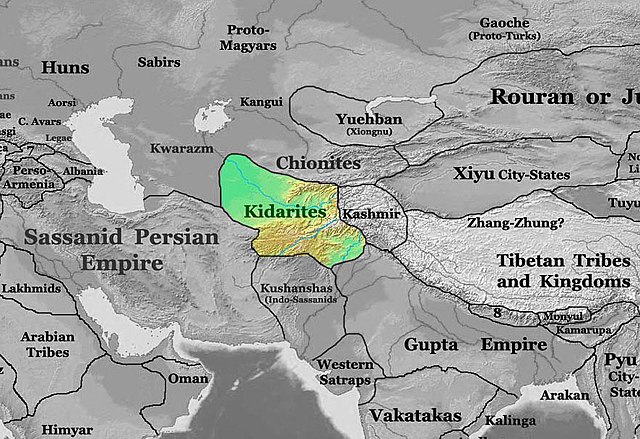
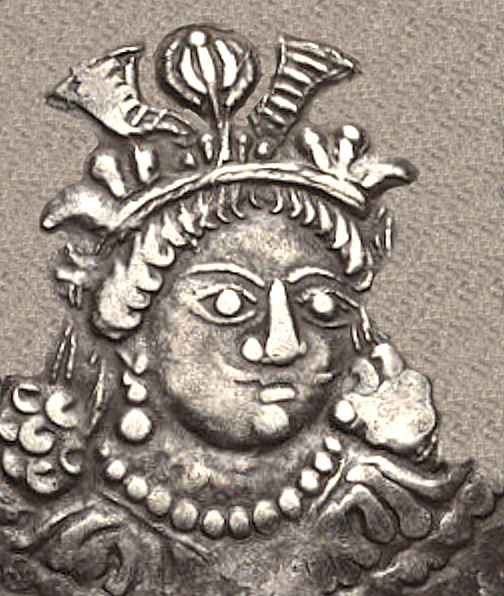
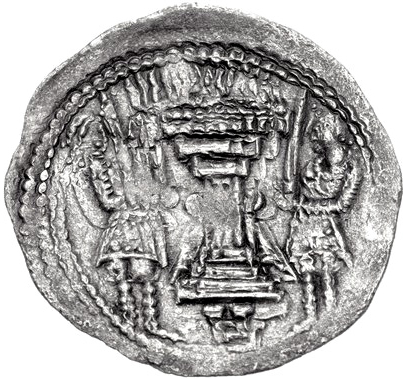

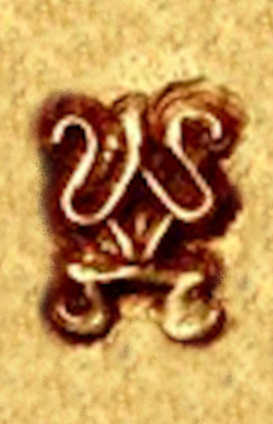
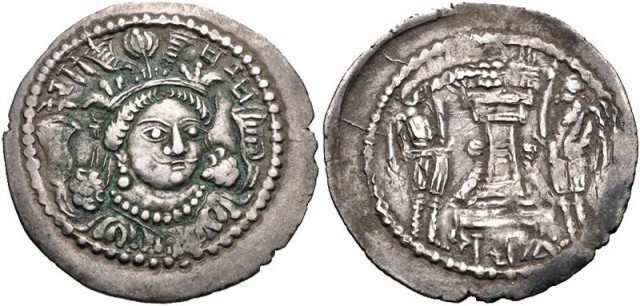
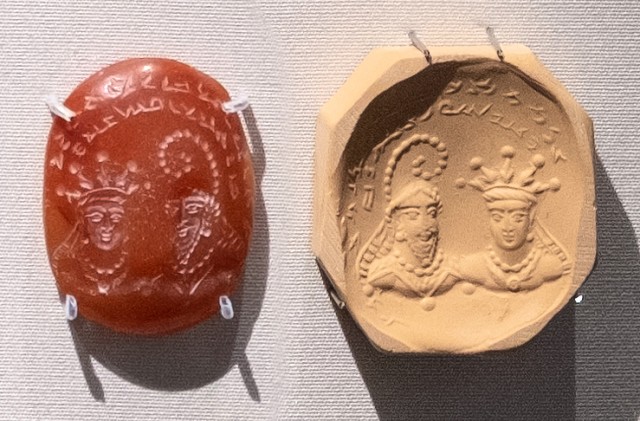
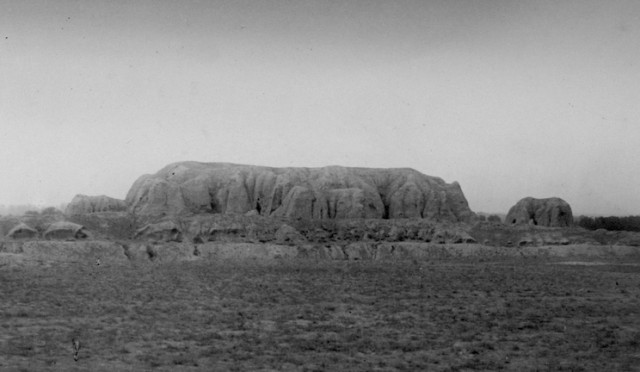
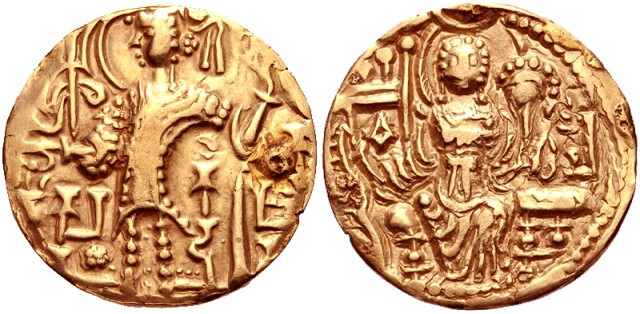
.jpg)
